
By this I mean fish where fish you are after have been caught. Buck Perry said " You can't catch em where they ain't"
Unless you have confidence the fish you seek are in the area you should rely on others experience to fish where they have been caught. High probability areas for flatheads are spawning areas ( water temp 60-70 degrees)
Flatheads spawn where they have the greatest control to guard their nests. I rate a hollow log as number 1. A planted spawning barrel as number 2. Undercut banks, muskrat/beaver holes, or undercut tree roots as number 3. And soft mud banks where flathead dig a site they can protect as number 4.
At not spawning times I would reccomend wood cover, such as logjams, culverts, undercut banks, culverts, or other areas which offer cover and ambush points best for flatheads. Daytime finds flatheads resting on creek and river channels where depth takes a break into deeper water.
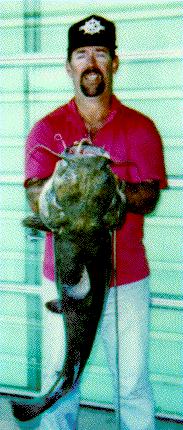
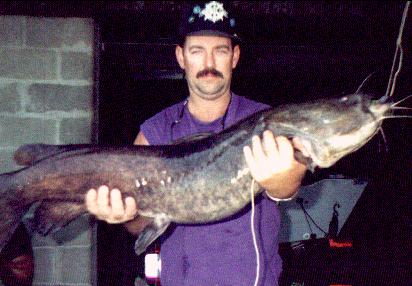
Springtime flatheads want to make baby flatheads! This is the most vulnerable and predictable time for flathead catfish. Spawning areas repeat from year to year. Often fish spawn in areas with less than 5 foot of depth. These areas offer best cover to protect nests and warmer water temperature. Young fry have cover and food they need to survive. Prespawn finds males in spawning areas building and protecting the best nest sites. The best sites are areas of bitter battle amongst the biggest strongest males. Prior to the females arrival the males exert enormous energy building and protecting sites that will entice females. The better the spawning site the bigger the male protecting it. He must stay to occupy the area so he must find food there. Find these sites and catch the prespawn males!(58-64 degree water temp) When females arrive males will no longer feed. They court the females and exhibit what a fine nesting site they have. Females look around and the same pecking order as the males occurs. The better the site the bigger the females. The females lay their eggs and the male fertilizes them. Even if the female is 20 pounds heavier than the male she will be driven from the nest. Males threaten and beat the females away from the nest. Normally the bigger females are rammed till bruised to force them away. They roam within 100 yards of the nest for several days. During this period the females will feed. This is the time when a fisherman can find and catch several fish in concentrated spawning areas. The males will not feed until the fry disperse to feed on their own. (Especially at night you will hear the males defending eggs and fry) They will not feed but reveal locations favorable to next years prespawn/spawn locations)
Dominant males will attempt to entice another female to the nesting site. I caught an extremely skinny male of 41 pounds once. The size of his head and the length of his body suggested he had once beeen a 50 pound fish. The best guess was that he had mated 3 times and did not feed for more than 8 weeks while he courted, spawned, and guarded fry 3 times.
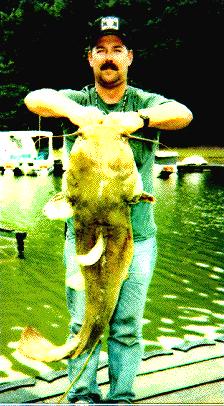
Flathead catfish eat other fish! I repeat the best bait for flathead catfish is lively baitfish. LIVE FISH COMPROMISE 98% OF THE DIET OF MATURE(20+lb) FLATHEAD DIET.
There are no magic baits for flatheads. Basically they will eat any live fish they can catch and get in their mouth. But experimentation and observation can reduce the piscatorial menu down to your favorite waters best bait.
If you harvest flatheads you can simply cut the stomach open and examine the contents. This will reveal what the fish has eaten which should equal his preferred meal. You can then offer that bait.
If you are like me and prefer to release the fish it becomes an experiment in trial and error. My partner and I baited with several different baits last year. When the first 5 fish we caught all chose the same bait our choice was simple. If however we had caught the flatheads on a varied assortment of baits we would have continued until a preference was established. We may have been in error by not offering an assortment of baits as the water warmed and feeding preferences changed.
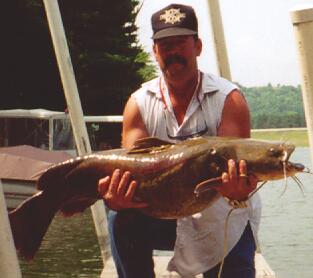
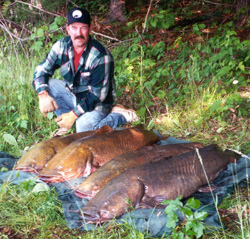
If you are serious about catching large flatheads your tackle should be capable to handling them. Flatheads that spool bass fishermen when they hit a crankbait or break a bream fishermens rod when they eat the caught fish are excusable. Any catman that fishes for flatheads and is not heavily enough equipped for the biggest flathead in his waters will get no sympathy from me.
Equipment failures are not an excuse to miss fish! Most are preventable. If you lack experience and a 50 pound flathead destroys your zebco 202 then I say you are the fool. Flatheads are brute power fish that requires raw strength in tackle or expert handling on light tackle. If in doubt about your abilities go for the brute stength side. Have a net large enough to engulf a fish 24 inches wide and 45 inches long. This should handle 99% of the flatheads on our planet. Do not attempt to lift heavy fish with the handle. My friends and I have broken enough landing nets to reccomend that you lift heavy flatheads by the hoop of the landing net. When you break a handle the big flathead has an extra chance at escape and you get to buy a new net! Have confidence in your fishing spot. Ed Davis sat on a log jam with his buddy. They believed it held big flatheads and they would feed. They waited 9 hours. Then they caught 3 flatheads. Average size 70 pounds! Don Wise was learning to fish for big flatheads. He spent 52 nights fishing in prime spots. He listened to experienced catmen as they explained why all of the tecniques were employed. He did not get a bite. It Rained on Don. He fished when frost formed on his boat. Mosquitoes torrmented him. He studied the catmen and the areas they fished and the reasons they used big baits. For a whole summer he endured these and the ridicule of fellow workers who followed his quest for giant flatheads. Yet he did not catch a big flathead. He did not get a bite! But the next Spring brought a change. A different lake. A change in the attitude of the flatheads. The same methods that had brought him disappointment the year before yielded results. Don caught flatheads. Don caught BIG flatheads. Don caught many big flatheads. This is the type of confidence and dedication that results in success. But during all this time Don was prepared to fight and land a huge flathead. When he got the first bite he was prepared to hook, fight and land a wild mean fish that had no thought of surrender. Even the first big flathead----Don released.

